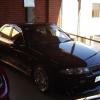After Some Mafless Ecu Options
Announcements
-
Similar Content
-
Latest Posts
-
By soviet_merlin · Posted
What does it look like with highway driving? And yes, I had a similar thought as Duncan. It looks quite similar in my Stagea and I have made myself accept it as normal. Might have to look into it some day -
While I was waiting for the new parts to come in for the charge pipe and radiator I decided to do some turbo modification. The drive pressure (exhaust backpressure) was a lot higher that I thought it should be. For 32lbs of boost drive was 55lbs. The turbine housing is a 1.10AR and my turbo builder has suggested to go to a 1.25AR. To test if a larger AR would do anything to reduce drive pressure AND not spend any money I decided to hog out the divider in my current housing. I removed it from the inlet and the whole way through the housing. After reassembly and testing it doesn't look like this modification did anything for reducing drive pressure or requiring more fuel (making more power). Oh well, it was worth a shot. We'll get some data at the track if it makes it past the 60ft. I also machined a $7 shift knob off Amazon to fit my Stillway shifter since I didn't like the Stillway shift knob. Next on the list was the radiator replacement and fabrication of a new intercooler tube that had no silicon coupler. No pictures of this - I was short on time each night after work to get this done and didn't stop to take pictures. Next was to get the clutch disks out and replaced. Previously when installing the dogbox I had ordered a set of the same sintered iron disks I had been running because I switched to the 26-spline input shaft. I thought it was odd that they didn't have any markings or brand name on them like all my old disks had but installed them anyway. At the track I could not get the clutch to lock up using my normal strategies. After two track nights I reached out to the clutch manufacturer and ask their thoughts. They said they had to switch the material out because they were having trouble getting the original material and that this new material would not take to being slipped very well. So out with the first set of 26-spline disks and in with the correct material 26-spline disks. While I had the trans out I added an inspection/service hole. I've wanted one of these for a while. Now I can have a look at things and change the front cover shimming when needed (clutch wear). I hustled and got the clutch change done in a few hours on a Saturday. Hopped in the car and drove home. On the way home I did a 1-3 pull. When shifting from 2nd to 3rd the core plug in the back of the cylinder head popped out and dumped all the coolant. Thankfully I was only 30 seconds from home and coasted it there. Datalog showed nothing unusual and 2.5psi of coolant pressure. That plug has been in there since 1992 but I guess it worked its way out. Pulled the trans AGAIN and replaced the plug, JB welded it in, and made a brace. Also deleted the head drain I had added in during the bearing issue fiasco. I am currently changing my boost control plumbing to make it cleaner. After that is done I'll make another attempt at getting past the 60.
-
140-150 across the board. At this point hoping the grounding harness fixes it. My grounds are all tied to the chassis and none to the battery. For SR and KA that’s never been a problem for me but had a few other guys here and Reddit who told me RB really like a very solid ground setup tied to the battery so going to try that next, I’m stumped if that doesn’t do it. Never had a car have spark and fuel and not fire off before. Only thing I can think is the spark is intermittent/weak because of grounds nothing else really makes sense at this point
-
By Nightmare_mistress_R33 · Posted
I am having close to the same issue. Can you help me with what wire you grounded to get your pump to trigger?
-







Recommended Posts
Create an account or sign in to comment
You need to be a member in order to leave a comment
Create an account
Sign up for a new account in our community. It's easy!
Register a new accountSign in
Already have an account? Sign in here.
Sign In Now